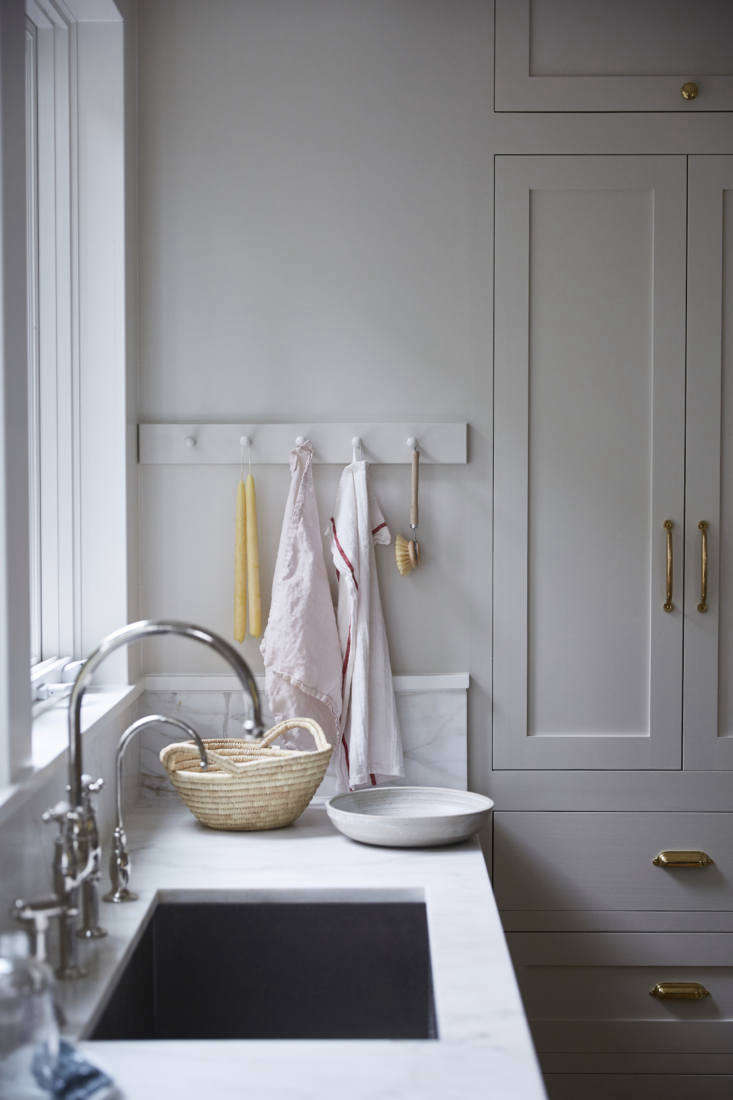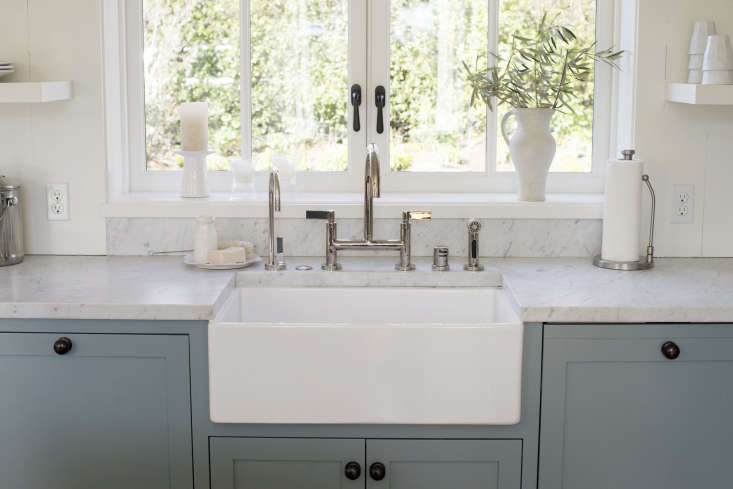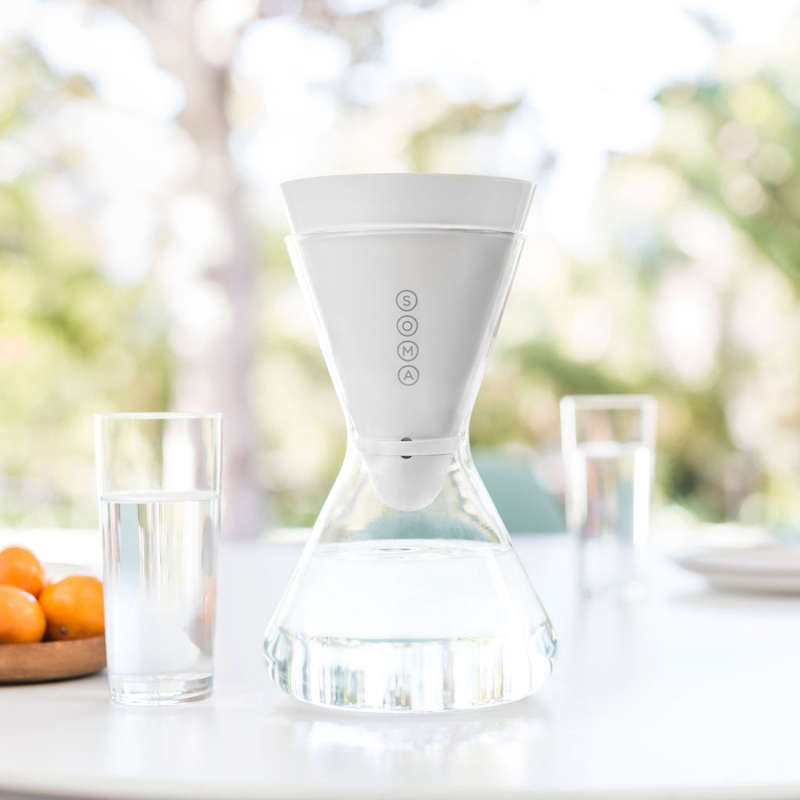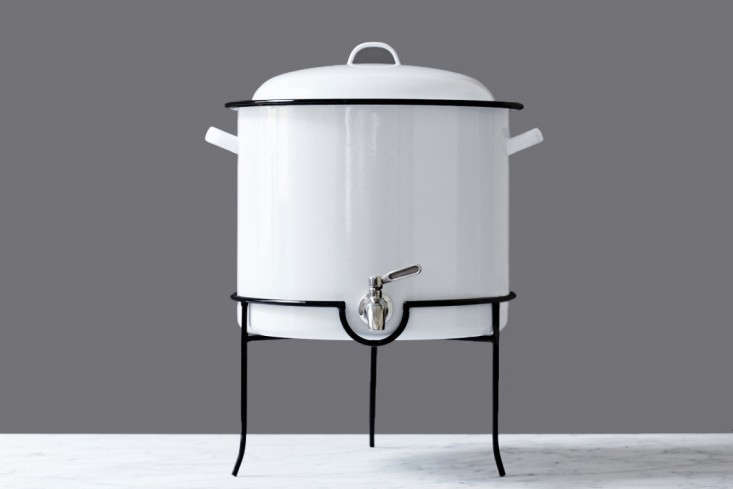For a long, long time, my husband and I made do with a Brita pitcher for our filtered water. We liked neither its inelegant design nor its cheap plastic composition, but it did its job fairly well. The worst part, though, may have been the constant refilling it required. And when both of us developed a serious seltzer habit, the problem was compounded (we kept a pitcher on the counter for still water and one in the fridge just for making the bubbly version).
A couple months ago, we decided it was time to take action and banish the Brita pitcher from our lives. The impetus: our kids, the reason for nearly every costly decision in our lives. We realized that they weren’t using the Brita pitcher for filtered water like the good lead-fearing citizens we thought we had brought them up to be. They were going straight to the tap for their drinking water. To them, it was simply the fastest route from point A (thirsty) to point B (quenched).
We researched alternative water filtering options that would 1) be either attractive or unobtrusive; 2) solve the constant-refilling issue; 3) work well; and 4) we could afford. What we ended up with: an under-sink water filter with a dedicated tap.

Before I go into the pros and cons of installing an under-sink water filtration system, here are other purification solutions we considered but ultimately nixed:
More attractive water filter pitchers: We tossed around the idea of simply purchasing a more attractive water filter pitcher, but as this solved only the aesthetics issue (and not the frequent refilling problem), we quickly dispensed with it. (If you’re in the market for one, though, see 10 Easy Pieces: Household Water Filters.)
The Berkey: A favorite here in the office because of its good looks (go here for our story about it) and with the survivalist community (and my husband) because of its emergency-readiness claims, the Big Berkey was a strong contender for a while. We liked its no-nonsense industrial design, and really loved that it doesn’t require the added expense of hiring a plumber to install. But it is, as its name suggests, large and would take up valuable counter space, a deal-breaker for our small kitchen.

Faucet-mounted filters: An add-on for the kitchen faucet, a faucet-mounted filter would solve our fundamental issues with the Brita (no more refilling, nothing to clutter up the counters), but we couldn’t get over the fact that they were clunky-looking.
Reverse osmosis water filter: According to Consumer Reports, it “can be extremely slow, rob cabinet space, and typically create 3 to 5 gallons of wastewater for every gallon filtered.”
Whole house water filter: I think our discussion about this type of filtration system, which is installed on the main water line and is necessary if you rely on well water, stopped shortly after this question was posed: “Wait, how much does it cost?”
The Winner: Under-Sink Filter

Taking into account our budget and space constraints, we ultimately went with an under-sink filter. Our plumber recommended the model that he liked best and helped us find a stone cutter who could drill a hole in our soapstone counter (we have an undermount sink) at a reasonable price. All told, it cost us less than $1,000, labor and parts included.
If you’re handy and don’t need an extra hole drilled (because you plan to either connect the filter to the main faucet or co-opt an existing hole—say, the one for the soap dispenser or the spray hose—to use for the water dispenser), you may be able to install it yourself and save hundreds of dollars. If you’re like us, though, and are tool-challenged, go to the pros. Just make sure to get multiple quotes. The first quote we received from a plumber was almost twice as much as what we ultimately paid!
Note: Many under-sink filters come with their own water dispensers (also called “bar faucets”). I didn’t like the one ours came with, so I sent the specs of the bar faucet I wanted to our plumber and asked him if we could use that one instead. All of which is to say, don’t feel like you have to use the dispenser your filter may come with.
Below, the pros and cons of an under-sink water filter.

Pros
It’s convenient. Oh, boy, is it nice not to need to refill a pitcher anymore.
There’s nothing to clutter the counters. Since the filtration system is under the sink, everything is out of sight.
It delivers targeted filtration. While whole-house systems, I’m sure, give owners peace of mind, I’m quite happy with our point-of-use filtration. After all, our family doesn’t need filtered water for washing dishes or showering (the water in our town has been relatively safe); we were mostly concerned with making sure our drinking water was filtered.
And better filtration, too. According to Wirecutter, “because under-sink filters use water pressure, not gravity, to push water through the filter, their filters can be denser, so they can remove a greater range of potential contaminants.”
The cartridge doesn’t need to be replaced as often. Six months of maintenance-free filtered water is a step up from our old Brita, which required a filter replacement every two months or so.
Cons
It’s not cheap. An under-sink filter is definitely pricier (ours cost about $200) than a Brita pitcher; and while you need to replace the cartridge less frequently, they are more expensive than Brita replacement filters.
It doesn’t chill your water. If you want cold-cold water, you’ll have to put it in the refrigerator or add ice cubes.
The flow is slow: We knew intellectually that the smaller faucet would dispense water at a slower rate than our kitchen faucet, but we were nonetheless surprised by its flow rate. It takes our little faucet about 16 seconds to fill up a 16-ounce glass. It doesn’t bother those of us in the family who are in the over-40 age group. The 13-and-under set, though? Let’s just say that I have caught both our boys going back to their old ways and sneaking water from the main faucet. Sigh. The good news is that most of the time, they do use our new filtered water dispenser.
It will take up some space under your sink…but not too much, thankfully.
The Verdict

Honestly, installing an under-sink water filter has been life-changing. It has simplified our domestic life and completely brought an end to our once-recurring argument of “whose turn is it to refill the pitchers?” My husband and I have, in fact, added it to our short list of luxuries that we thought we didn’t need but in hindsight are totally worth it. (Also on that list: a backup camera in the car. Why didn’t we get that?)
For more in our “Is It Worth It?” series, see:
- Soapstone Counters: Are They Worth It?
- Is It Worth It: The Aarke Countertop Premium Carbonator from Sweden
- Is It Worth It? The Lowdown on Luxe Sheets by Sferra




Have a Question or Comment About This Post?
Join the conversation (12)